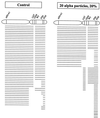Induction of a bystander mutagenic effect of alpha particles in mammalian cells
- PMID: 10681418
- PMCID: PMC15760
- DOI: 10.1073/pnas.030420797
Induction of a bystander mutagenic effect of alpha particles in mammalian cells
Abstract
Ever since the discovery of X-rays was made by Röntgen more than a hundred years ago, it has always been accepted that the deleterious effects of ionizing radiation such as mutation and carcinogenesis are attributable mainly to direct damage to DNA. Although evidence based on microdosimetric estimation in support of a bystander effect appears to be consistent, direct proof of such extranuclear/extracellular effects are limited. Using a precision charged particle microbeam, we show here that irradiation of 20% of randomly selected A(L) cells with 20 alpha particles each results in a mutant fraction that is 3-fold higher than expected, assuming no bystander modulation effect. Furthermore, analysis by multiplex PCR shows that the types of mutants induced are significantly different from those of spontaneous origin. Pretreatment of cells with the radical scavenger DMSO had no effect on the mutagenic incidence. In contrast, cells pretreated with a 40 microM dose of lindane, which inhibits cell-cell communication, significantly decreased the mutant yield. The doses of DMSO and lindane used in these experiments are nontoxic and nonmutagenic. We further examined the mutagenic yield when 5-10% of randomly selected cells were irradiated with 20 alpha particles each. Results showed, likewise, a higher mutant yield than expected assuming no bystander effects. Our studies provide clear evidence that irradiated cells can induce a bystander mutagenic response in neighboring cells not directly traversed by alpha particles and that cell-cell communication process play a critical role in mediating the bystander phenomenon.
Figures




References
-
- Samet J M. J Natl Cancer Inst. 1989;81:745–757. - PubMed
-
- Lubin J H, Boice J D. J Natl Cancer Inst. 1997;89:49–57. - PubMed
-
- Lubin J H, Boice J D, Jr, Edling C. Radon and Lung Cancer Risk: A Joint analysis of 11 Underground Miner Studies. Bethesda, MD: National Institutes of Health; 1994.
-
- Puskin J S, Boice J D., Jr J Air Pollut Control Assoc. 1989;39:915–920.
-
- Kennedy C H, Mitchell C E, Fukushima N H, Neft R E, Lechner J F. Carcinogenesis. 1996;17:1671–1676. - PubMed
Publication types
MeSH terms
Substances
Grants and funding
LinkOut - more resources
Full Text Sources
Other Literature Sources

